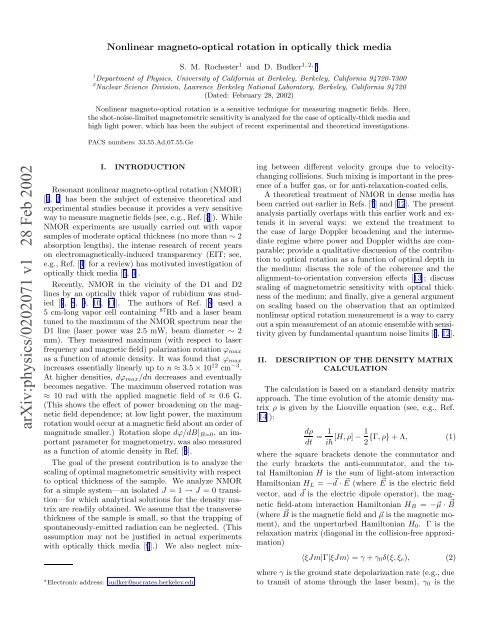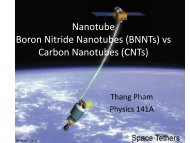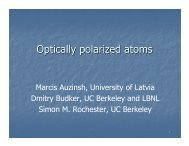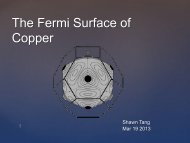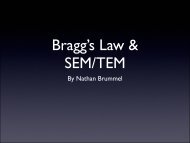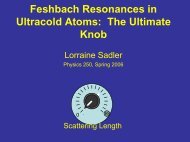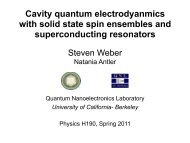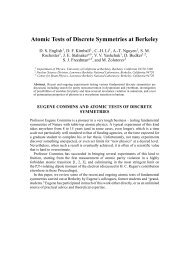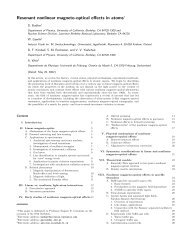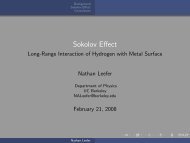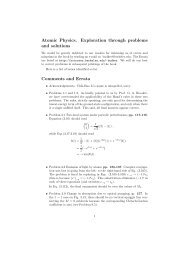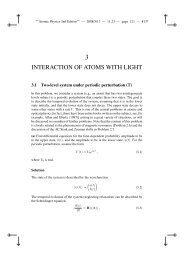Nonlinear magneto-optical rotation in optically thick media
Nonlinear magneto-optical rotation in optically thick media
Nonlinear magneto-optical rotation in optically thick media
Create successful ePaper yourself
Turn your PDF publications into a flip-book with our unique Google optimized e-Paper software.
<strong>Nonl<strong>in</strong>ear</strong> <strong>magneto</strong>-<strong>optical</strong> <strong>rotation</strong> <strong>in</strong> <strong>optical</strong>ly <strong>thick</strong> <strong>media</strong>S. M. Rochester 1 1, 2, ∗and D. Budker1 Department of Physics, University of California at Berkeley, Berkeley, California 94720-73002 Nuclear Science Division, Lawrence Berkeley National Laboratory, Berkeley, California 94720(Dated: February 28, 2002)<strong>Nonl<strong>in</strong>ear</strong> <strong>magneto</strong>-<strong>optical</strong> <strong>rotation</strong> is a sensitive technique for measur<strong>in</strong>g magnetic fields. Here,the shot-noise-limited <strong>magneto</strong>metric sensitivity is analyzed for the case of <strong>optical</strong>ly-<strong>thick</strong> <strong>media</strong> andhigh light power, which has been the subject of recent experimental and theoretical <strong>in</strong>vestigations.PACS numbers: 33.55.Ad,07.55.GearXiv:physics/0202071 v1 28 Feb 2002I. INTRODUCTIONResonant nonl<strong>in</strong>ear <strong>magneto</strong>-<strong>optical</strong> <strong>rotation</strong> (NMOR)[1, 2] has been the subject of extensive theoretical andexperimental studies because it provides a very sensitiveway to measure magnetic fields (see, e.g., Ref. [3]). WhileNMOR experiments are usually carried out with vaporsamples of moderate <strong>optical</strong> <strong>thick</strong>ness (no more than ∼ 2absorption lengths), the <strong>in</strong>tense research of recent yearson electromagnetically-<strong>in</strong>duced transparency (EIT; see,e.g., Ref. [4] for a review) has motivated <strong>in</strong>vestigation of<strong>optical</strong>ly <strong>thick</strong> <strong>media</strong> [5, 6].Recently, NMOR <strong>in</strong> the vic<strong>in</strong>ity of the D1 and D2l<strong>in</strong>es by an <strong>optical</strong>ly <strong>thick</strong> vapor of rubidium was studied[7, 8, 9, 10, 11]. The authors of Ref. [8] used a5 cm-long vapor cell conta<strong>in</strong><strong>in</strong>g 87 Rb and a laser beamtuned to the maximum of the NMOR spectrum near theD1 l<strong>in</strong>e (laser power was 2.5 mW, beam diameter ∼ 2mm). They measured maximum (with respect to laserfrequency and magnetic field) polarization <strong>rotation</strong> ϕ maxas a function of atomic density. It was found that ϕ max<strong>in</strong>creases essentially l<strong>in</strong>early up to n ≈ 3.5 × 10 12 cm −3 .At higher densities, dϕ max /dn decreases and eventuallybecomes negative. The maximum observed <strong>rotation</strong> was≈ 10 rad with the applied magnetic field of ≈ 0.6 G.(This shows the effect of power broaden<strong>in</strong>g on the magneticfield dependence; at low light power, the maximum<strong>rotation</strong> would occur at a magnetic field about an order ofmagnitude smaller.) Rotation slope dϕ/dB| B=0 , an importantparameter for <strong>magneto</strong>metry, was also measuredas a function of atomic density <strong>in</strong> Ref. [8].The goal of the present contribution is to analyze thescal<strong>in</strong>g of optimal <strong>magneto</strong>metric sensitivity with respectto <strong>optical</strong> <strong>thick</strong>ness of the sample. We analyze NMORfor a simple system—an isolated J = 1 → J = 0 transition—forwhich analytical solutions for the density matrixare readily obta<strong>in</strong>ed. We assume that the transverse<strong>thick</strong>ness of the sample is small, so that the trapp<strong>in</strong>g ofspontaneously-emitted radiation can be neglected. (Thisassumption may not be justified <strong>in</strong> actual experimentswith <strong>optical</strong>ly <strong>thick</strong> <strong>media</strong> [9].) We also neglect mix-∗ Electronic address: budker@socrates.berkeley.edu<strong>in</strong>g between different velocity groups due to velocitychang<strong>in</strong>gcollisions. Such mix<strong>in</strong>g is important <strong>in</strong> the presenceof a buffer gas, or for anti-relaxation-coated cells.A theoretical treatment of NMOR <strong>in</strong> dense <strong>media</strong> hasbeen carried out earlier <strong>in</strong> Refs. [7] and [12]. The presentanalysis partially overlaps with this earlier work and extendsit <strong>in</strong> several ways: we extend the treatment tothe case of large Doppler broaden<strong>in</strong>g and the <strong>in</strong>ter<strong>media</strong>teregime where power and Doppler widths are comparable;provide a qualitative discussion of the contributionto <strong>optical</strong> <strong>rotation</strong> as a function of <strong>optical</strong> depth <strong>in</strong>the medium; discuss the role of the coherence and thealignment-to-orientation conversion effects [13]; discussscal<strong>in</strong>g of <strong>magneto</strong>metric sensitivity with <strong>optical</strong> <strong>thick</strong>nessof the medium; and f<strong>in</strong>ally, give a general argumenton scal<strong>in</strong>g based on the observation that an optimizednonl<strong>in</strong>ear <strong>optical</strong> <strong>rotation</strong> measurement is a way to carryout a sp<strong>in</strong> measurement of an atomic ensemble with sensitivitygiven by fundamental quantum noise limits [3, 12].II.DESCRIPTION OF THE DENSITY MATRIXCALCULATIONThe calculation is based on a standard density matrixapproach. The time evolution of the atomic density matrixρ is given by the Liouville equation (see, e.g., Ref.[14]):dρdt = 1i¯h [H, ρ] − 1 {Γ, ρ} + Λ, (1)2where the square brackets denote the commutator andthe curly brackets the anti-commutator, and the totalHamiltonian H is the sum of light-atom <strong>in</strong>teractionHamiltonian H L = −d ⃗ · ⃗E (where E ⃗ is the electric fieldvector, and d ⃗ is the electric dipole operator), the magneticfield-atom <strong>in</strong>teraction Hamiltonian H B = −⃗µ · ⃗B(where B ⃗ is the magnetic field and ⃗µ is the magnetic moment),and the unperturbed Hamiltonian H 0 . Γ is therelaxation matrix (diagonal <strong>in</strong> the collision-free approximation)〈ξJm|Γ|ξJm〉 = γ + γ 0 δ(ξ, ξ e ), (2)where γ is the ground state depolarization rate (e.g., dueto transit of atoms through the laser beam), γ 0 is the
spontaneous decay rate from the upper state, and ξ representsthe quantum number dist<strong>in</strong>guish<strong>in</strong>g the groundstate (ξ g ) from the excited state (ξ e ). Λ = Λ 0 + Λ repop isthe pump<strong>in</strong>g term, where the diagonal matrixdescribes <strong>in</strong>coherent ground state pump<strong>in</strong>g (ρ 0atomic density), and2is the〈ξ g J g m|Λ 0 |ξ g J g m〉 =γρ 0(2J g + 1)(3)〈ξ g J g m|Λ repop |ξ g J g m ′ 〉 = γ 0∑m e,m ′ e ,q 〈J g , m, 1, q|J e , m e 〉〈J g , m ′ , 1, q|J e , m ′ e 〉ρ ξ eJ em eξ eJ em ′ e , (4)describes repopulation due to spontaneous relaxationfrom the upper level (see, e.g., Ref. [15]). Here 〈. . .| . . .〉are the Clebsch-Gordan coefficients.The electric field vector is written (see, e.g., Ref. [16])⃗E = 1 []E 0 e iφ (cos ϕ cos ɛ − i s<strong>in</strong> ϕ s<strong>in</strong> ɛ)e i(ωt−kz) + c.c. ˆx2+ 1 []E 0 e iφ (s<strong>in</strong> ϕ cos ɛ + i cos ϕ s<strong>in</strong> ɛ)e i(ωt−kz) + c.c. ŷ,2(5)where ω is the light frequency, k = ω/c is the vacuumwave number, E 0 is the electric field amplitude, ϕ is thepolarization angle, ɛ is the ellipticity (arctangent of theratio of the major and m<strong>in</strong>or axes of the polarizationellipse), and φ is the overall phase. By substitut<strong>in</strong>g (5)<strong>in</strong>to the wave equation( ) ω2c 2 + d2 ⃗Edz 2 = − 4π d 2c 2 dt ⃗ 2 P, (6)where ⃗ P = T r(ρ ⃗ d) is the polarization of the medium, theabsorption, <strong>rotation</strong>, phase shift, and change of ellipticityper unit distance for an <strong>optical</strong>ly th<strong>in</strong> medium canbe found <strong>in</strong> terms of the density matrix elements (theseexpressions are given <strong>in</strong> Ref. [17]). Once the solutionsfor the density matrix are obta<strong>in</strong>ed, we will perform an<strong>in</strong>tegration to generalize the result to <strong>media</strong> of arbitrary<strong>thick</strong>ness.III.THE DOPPLER-FREE CASEWe consider the case of a J = 1 → J = 0 transition,and l<strong>in</strong>early-polarized <strong>in</strong>cident light, with a magneticfield directed along the light propagation direction(Faraday geometry). Us<strong>in</strong>g the rotat<strong>in</strong>g wave approximation,the solution of Eq. (1) is obta<strong>in</strong>ed, and from this,analytic expressions for th<strong>in</strong> medium absorption and <strong>rotation</strong>are found. These expressions can be simplified byassum<strong>in</strong>g that γ ≪ γ 0 . We first consider the case wherethe power-broadened l<strong>in</strong>e width is much greater than theDoppler width. In this case, the absorption coefficientper unit length α is found to beα ≈α 0(2∆/γ 0 ) 2 + 2κ/3 + 1 , (7)where ∆ is the light-frequency detun<strong>in</strong>g from resonance,κ = d2 E 2 0¯h 2 γγ 0(8)is the <strong>optical</strong> pump<strong>in</strong>g saturation parameter, andα 0 ≈ 16π λ2 n (9)is the unsaturated absorption coefficient on resonance,where λ is the transition wavelength and n is the atomicdensity. For Ω ≪ γ, where Ω = gµB is the Larmorfrequency (g is the Landé factor, and µ is the Bohr<strong>magneto</strong>n), the slope of <strong>optical</strong> <strong>rotation</strong> per unit length,dϕ/(dΩdx), (proportional to <strong>rotation</strong> for small magneticfields) is found to bedϕdΩdx ≈ 1 α 0γ (2∆/γ 0 ) 2 + 2κ/3 , (10)where we have neglected l<strong>in</strong>ear <strong>optical</strong> <strong>rotation</strong>. Ingeneral, <strong>optical</strong> <strong>rotation</strong> can be <strong>in</strong>duced by either l<strong>in</strong>eardichroism or circular birefr<strong>in</strong>gence. Analysis of thesteady-state polarization of the ground state shows thatboth processes contribute here: the contribution due tol<strong>in</strong>ear dichroism <strong>in</strong>duced <strong>in</strong> the medium is given bydϕdΩdx∣ ≈ 1 1α 0dichr.γ 1 + (2∆/γ 0 ) 2 (2∆/γ 0 ) 2 + 2κ/3 , (11)and the contribution due to circular birefr<strong>in</strong>gence (aris<strong>in</strong>gdue to alignment-to-orientation conversion <strong>in</strong> the presenceof both the magnetic field and the strong electricfield of the light [13]) is given bydϕdΩdx∣ ≈ 1 (2∆/γ 0 ) 2 α 0biref.γ 1 + (2∆/γ 0 ) 2 (2∆/γ 0 ) 2 + 2κ/3 . (12)
3The sum of the two contributions produces theLorentzian l<strong>in</strong>e shape of Eq. (10).We now generalize the formulas for absorption and<strong>rotation</strong> to the case of <strong>thick</strong> <strong>media</strong>, and f<strong>in</strong>d the <strong>magneto</strong>metricsensitivity. In the Doppler-free case we arepresently consider<strong>in</strong>g, we can further simplify the expressionsby assum<strong>in</strong>g ∆ = 0 (we will have to <strong>in</strong>cludenon-zero detun<strong>in</strong>gs <strong>in</strong> the discussion of the Dopplerbroadenedcase below), and κ ≫ 1. (We will see fromthe f<strong>in</strong>al result that this holds everywhere <strong>in</strong> the mediumwhen the <strong>in</strong>put light power is optimal.) Generally, themedium <strong>in</strong> the presence of a magnetic field produces lightellipticity as well as <strong>rotation</strong>; however, the ellipticity isan odd function of detun<strong>in</strong>g and is zero on resonance.The rate of change of the saturation parameter as lighttravels through the medium is given bydκ(x)dx= −ακ(x)≈ − 3 2 α 0, (13)so solv<strong>in</strong>g for the saturation parameter as a function ofposition,κ(x) ≈ κ 0 − 3 2 α 0x, (14)where κ 0 is the saturation parameter at x = 0.The contribution to the small-field <strong>optical</strong> <strong>rotation</strong> ofthe “slice” of the medium at position x is found by substitut<strong>in</strong>gEq. (14) <strong>in</strong>to Eq. (10):dϕdΩdx (x) ≈ 1 α 0γ 2κ 0 /3 − α 0 x . (15)This contribution is plotted as a function of position <strong>in</strong>Fig. 1. The plot illustrates that the part of the mediumnear its end contributes significantly more to the overall<strong>rotation</strong> than the part near its beg<strong>in</strong>n<strong>in</strong>g. This is becauselight power, and correspond<strong>in</strong>gly, the light broaden<strong>in</strong>g ofthe resonance, is lower at the end of the medium [theratio of the <strong>rotation</strong> per unit length is approximatelyκ(l)/κ 0 ≈ 1 − (3/2)α 0 l/κ 0 ]. Integrat<strong>in</strong>g over the lengthl of the medium gives the total slope:∫dϕ ldΩ =0∫ ldϕdΩdx (x)dxα 0≈ 1 γ 0 2κ 0 /3 − α 0 x dx= 1 (γ ln κ 0κ 0 − 3α 0 l/2). (16)The slope (16) is plotted as a function of α 0 l <strong>in</strong> Fig. 2.The photon shot-noise-limited <strong>magneto</strong>metric sensitivityδB [22] is given <strong>in</strong> terms of the number N γ of transmittedphotons per unit time, the slope of <strong>rotation</strong> withdφddxΓ{5432100 0.2 0.4 0.6 0.8 1x{FIG. 1: Normalized contribution to small-field slope (<strong>in</strong> radians)of a slice of the medium of width dx at position x, givenby Eq. 15. We have set κ 0 = 1.8α 0l, the value which is laterseen to produce the greatest <strong>magneto</strong>metric sensitivity.dφdΓ5432100 0.2 0.4 0.6 0.8 1q 1FIG. 2: Normalized slope (<strong>in</strong> radians) of NMOR as a functionof <strong>optical</strong> <strong>thick</strong>ness of the medium [q −1 = (3/2)α 0l/κ 0].The value of q −1 that produces the greatest <strong>magneto</strong>metricsensitivity is shown with a dashed l<strong>in</strong>e.respect to B, and the measurement time t:(δB) −1 = 2 dϕ √Nγ tdBdϕ= gµω¯hc≈ gµω¯hc= gµω¯hcdΩ√√3π√2Atπ γκ(l)2At κ 0 − 3 2 α 0llnπ γ((Atα 0 l√ q − 1 lnγκ 0κ 0 − 3α 0 l/2qq − 1)), (17)where A is the cross-sectional area of the light beam andwe have made the change of variables κ 0 = 3qα 0 l/2. Thefactor√q − 1 ln(qq − 1reaches a maximum of ∼ 0.8 at q ≈ 1.2 so we see that for<strong>media</strong> of sufficient <strong>thick</strong>ness, i.e. where α 0 l ≫ 3, and for)
4the optimum <strong>in</strong>itial saturation parameter κ 0 ≈ 1.8α 0 l,we have from Eq. (14) that κ(x) ≫ 1 for all x. For theoptimum light <strong>in</strong>tensity, then,√(δB) −1 ≈ 0.8 gµω Atα 0 l¯hc≈ 1.1 gµ¯hγ√Alntγ . (18)This result is consistent with the general observation [3]that optimized NMOR provides a method for measur<strong>in</strong>ga sp<strong>in</strong>-system at the standard quantum limit (SQL) givenby sp<strong>in</strong>-projection noise [23]. The sensitivity is then expectedto scale as the square root of the product of thenumber of available atoms and the sp<strong>in</strong>-relaxation time(see, e.g., Ref. [18], Sec. 3.1.1), which is <strong>in</strong>deed the result(18).IV.THE DOPPLER-BROADENED CASENow we consider the case where the Doppler width Γis much greater than the power-broadened l<strong>in</strong>e width. Inthis case, we need to average over the over the atomic velocitydistribution, which is equivalent to averag<strong>in</strong>g overthe Doppler-free spectral profiles. On resonance with theDoppler broadened transition, the absorption coefficientis given byα DB ≈ 1 √ πΓ∫ ∞−∞≈ α ∫ ∞0√ πΓ=√3π8γ 0Γ−∞α(∆)d∆d∆(2∆/γ 0 ) 2 + 2κ/3α 0√ κ. (19)In this case the Doppler-broadened unsaturated absorbtioncoefficient is given <strong>in</strong> terms of the Doppler-free unsaturatedabsorbtion coefficient by√ πα 0 | DB=2γ 0Γ α 0. (20)Compar<strong>in</strong>g Eqs. (19) and (7), we see that we have reproduceda well-known result (see, e.g., Ref. [19], Sec.7.2.1) that resonant absorption falls as 1/κ for Dopplerfree<strong>media</strong> and as 1/ √ κ for Doppler-broadened <strong>media</strong>when κ ≫ 1. The change <strong>in</strong> κ per unit length isdκ(x)dx= −α DBκ(x)√6π γ 0≈ −4 Γ α √0 κ(x), (21)and solv<strong>in</strong>g for κ as a function of position,( √ ) 2√ 6π γ 0κ(x) ≈ κ0 −8 Γ α 0x . (22)Note that the behavior of the saturation parameter as afunction of distance is different <strong>in</strong> the Doppler-broadenedcase compared to the Doppler-free case [cf. Eq. (14)]where the saturation parameter falls approximately l<strong>in</strong>earlywith distance.Tak<strong>in</strong>g the average of small-field <strong>rotation</strong> over theDoppler distribution givesdϕdΩdx∣ ≈ 1 ∫ ∞√DBπΓ −∞≈ α ∫ ∞0√ πγΓ≈√6π4γ 0Γ−∞dϕdΩdx (∆)d∆1(2∆/γ 0 ) 2 + 2κ/3 d∆α 0γ √ κ . (23)We see that the <strong>rotation</strong> per unit length scales as 1/ √ κ,<strong>in</strong> contrast to the 1/κ scal<strong>in</strong>g for the Doppler-free case[similar to the situation with absorption, Eqs. (7,19)].This is because the number of atoms produc<strong>in</strong>g the effectis, <strong>in</strong> a sense, not fixed; with <strong>in</strong>creas<strong>in</strong>g light power, alarger fraction of the Doppler distribution is <strong>in</strong>volved.Substitut<strong>in</strong>g (22) <strong>in</strong>to Eq. (23) to f<strong>in</strong>d the contributionto the slope as a function of position givesdϕdΩdx (x) ∣ ∣∣∣DB≈ 2 γα 08 √6πΓγ 0√κ0 − α 0 x . (24)It is <strong>in</strong>terest<strong>in</strong>g to note that while the light power andthe <strong>rotation</strong> slope per unit length behave differently <strong>in</strong>the Doppler-broadened case compared to the Dopplerfreecase, Eq. (24) has the same functional form as forthe Doppler-free case [Eq. (15)].Integrat<strong>in</strong>g over the length of the medium, we obta<strong>in</strong>∫dϕl∣ dϕ ∣∣∣DBdΩ∣ ≈DBdΩdx (x) dx≈ 2 γ0∫ l0√8Γ6π γα 0√κ0 − α 0 x dx(= 2 √γ ln κ0√κ0 − √ 6π γ 0Γ8α 0 l). (25)The behavior of (25) as a function of α 0 l is qualitativelysimilar to that of Eq. (16) shown <strong>in</strong> Fig. 2. However, thedependence on κ 0 is different.The <strong>magneto</strong>metric sensitivity is given by(δB) −1DB= gµω¯hc≈ gµω¯hc= gµω¯hc√dϕ2AtdΩ∣ DBπ γκ(l)√8Atπγ√ √32( √ ) ( √ )√ 6π γ 0κ0 −8 Γ α κ00l ln √κ0 − √ 6π γ 0Γ8α 0 l( )At γ 0pγ Γ α 0l(p − 1) ln , (26)p − 1
5with the change of variablesThe factorκ 0 = 3π (p γ )0 2.64 Γ α 0l(27)( ) p(p − 1) lnp − 1goes to unity as p goes to <strong>in</strong>f<strong>in</strong>ity; it is approximately 0.9at p = 5. (Further ga<strong>in</strong> from <strong>in</strong>creased power is m<strong>in</strong>imal,and if the power becomes too high, the approximationof the Doppler width be<strong>in</strong>g much larger than the powerbroadenedwidth breaks down.) Thus, <strong>in</strong> this case,√(δB) −1DB ≈ 0.8gµω ¯hc≈ 0.3 gµ¯h λlnγ 0ΓAt γ 0γ Γ α 0l√Atγ , (28)for sufficiently high κ 0 .This result, where sensitivity <strong>in</strong>creases l<strong>in</strong>early with<strong>optical</strong> <strong>thick</strong>ness, holds for the case where the powerbroadenedwidth ∼ γ 0√κ(x) is smaller than the Dopplerwidth for all x with<strong>in</strong> the sample, i.e.1 ≪ κ 0 ≪ (Γ/γ 0 ) 2 andΓ/γ 0 ≪ α 0 l ≪ (Γ/γ 0 ) 2 , (29)s<strong>in</strong>ce α 0 l is related to κ 0 by Eq. (27). As power and<strong>optical</strong> <strong>thick</strong>ness are <strong>in</strong>creased beyond this range, i.e.κ 0 ≫ (Γ/γ 0 ) 2 andα 0 l ≫ (Γ/γ 0 ) 2 , (30)we obta<strong>in</strong> the Doppler-free case, where sensitivity <strong>in</strong>creasesas the square root of the <strong>thick</strong>ness [Eq. (18)].V. THE GENERAL CASEA numerical result can be obta<strong>in</strong>ed for the general casewhere the restrictions (29,30) on κ and α 0 l are removed.In a typical experiment, light power is ∼ 1 mW, the laserbeam diameter is ∼ 0.1 cm, λ ≈ 800 nm, and Γ/γ 0 ≈ 60.Thus the effective ground state relaxation rate due to thetransit of atoms through the laser beam is γ ≈ 2π·50 kHzand the <strong>in</strong>itial saturation parameter is κ 0 ≈ 4 × 10 3 .Here, as <strong>in</strong> a typical experimental procedure, the <strong>optical</strong>depth is varied (by chang<strong>in</strong>g atomic density) whilethe laser power is kept constant. Normalized transmission,differential small-field <strong>rotation</strong>, total small-field <strong>rotation</strong>,and <strong>magneto</strong>metric sensitivity are plotted <strong>in</strong> Fig.3 as a function of <strong>optical</strong> depth. For small <strong>optical</strong> depth,κ > (Γ/γ 0 ) 2 and the medium is effectively Doppler-free.Transmission (∝ κ) falls l<strong>in</strong>early until the transition tothe Doppler-broadened case is made (dashed l<strong>in</strong>e). ThendφddΑ0{Γ Κ0310 3a210 3110 3310 30b210 3110 306c42040d2000 210 3 410 3 Α610 3{810 3 1010 3410 3dφdΓ Κ dφdΓFIG. 3: Normalized (a) saturation parameter, (b) differentialsmall-field <strong>rotation</strong>, (c) total small-field <strong>rotation</strong>, and (d) <strong>in</strong>verse<strong>magneto</strong>metric sensitivity as a function of <strong>optical</strong> depthwith <strong>in</strong>itial saturation parameter κ 0 = 4×10 3 and Γ/γ 0 = 60.Plots (b), (c), and (d) are <strong>in</strong> units of radians. The dashed l<strong>in</strong>e<strong>in</strong>dicates the transition from the Doppler-free to the Dopplerbroadenedregime [κ = (Γ/γ 0) 2 ], and the dotted l<strong>in</strong>e <strong>in</strong>dicatesthe po<strong>in</strong>t at which non-l<strong>in</strong>ear effects beg<strong>in</strong> to turn off (κ = 1).L<strong>in</strong>ear <strong>optical</strong> <strong>rotation</strong> is neglected <strong>in</strong> this plot. The solid l<strong>in</strong>e<strong>in</strong>dicates the <strong>optical</strong> depth at which maximum sensitivity isachieved.transmission falls quadratically until the l<strong>in</strong>ear regime isreached (dotted l<strong>in</strong>e), after which it falls exponentially.Differential small-field <strong>rotation</strong> (∝ dϕ/[dΩd(α 0 l)]γ) <strong>in</strong>itiallyrises, as κ falls and power broaden<strong>in</strong>g is reduced,until non-l<strong>in</strong>ear effects beg<strong>in</strong> to turn off. (L<strong>in</strong>ear <strong>optical</strong><strong>rotation</strong> is neglected <strong>in</strong> this plot.) S<strong>in</strong>ce <strong>magneto</strong>metricsensitivity depends both on total <strong>optical</strong> <strong>rotation</strong> andtransmission, an <strong>in</strong>ter<strong>media</strong>te value for the <strong>optical</strong> depthproduces the greatest sensitivity (solid l<strong>in</strong>e). Multiply<strong>in</strong>gthe normalized <strong>in</strong>verse sensitivity dϕ/dΩ · γ √ κ by2 √ 2π gµ¯h√A(λ √ γ ≈ 108 G/ √ ) −1Hz (31)
maxΓ φmax rad20151050302010ab00 210 3 410 3 610 3 810 3 1010 3Α 0 {The maximum <strong>optical</strong> <strong>rotation</strong> with respect to magneticfield can be determ<strong>in</strong>ed with a numerical calculation.Maximum <strong>rotation</strong> is plotted as a function of <strong>optical</strong>depth <strong>in</strong> Fig. 4, for the same parameters as usedfor Fig. 3. The <strong>rotation</strong> <strong>in</strong>itially rises l<strong>in</strong>early, the samebehavior seen <strong>in</strong> the experiment [8] mentioned <strong>in</strong> the <strong>in</strong>troduction.For large <strong>optical</strong> depth, however, <strong>rotation</strong> <strong>in</strong>Fig. 4 then beg<strong>in</strong>s to rise more quickly, and f<strong>in</strong>ally saturates,whereas experimentally a slower <strong>in</strong>crease and thena decrease <strong>in</strong> <strong>rotation</strong> is seen. This is evidence for an additionalrelaxation mechanism not accounted for <strong>in</strong> thepresent theory; <strong>in</strong> Ref. [8] it is attributed to the effect ofradiation trapp<strong>in</strong>g.6FIG. 4: (a) Maximum <strong>optical</strong> <strong>rotation</strong> and (b) normalizedmagnetic field at which <strong>rotation</strong> is maximum as a function of<strong>optical</strong> depth. Parameters are the same as those used for Fig.3.VII.CONCLUSIONgives the absolute magnitude of sensitivity, ∼ 2 ×10 −10 G/ √ Hz (we assume g = 1). Although this sensitivityis not as high as could be achieved with lowatomic density paraff<strong>in</strong>-coated cells (∼ 3×10 −12 G/ √ Hz[3]), it is, nevertheless, sufficiently high to be of <strong>in</strong>terest<strong>in</strong> practical applications [10]. In particular, the powerbroaden<strong>in</strong>gof the magnetic field dependence of <strong>optical</strong><strong>rotation</strong> at high light power provides an <strong>in</strong>creased dynamicrange for <strong>magneto</strong>metry over the low-power case.There are, however, techniques for shift<strong>in</strong>g the narrowresonance obta<strong>in</strong>ed with a paraff<strong>in</strong>-coated cell to highermagnetic fields, e.g., frequency modulation of the laserlight [20].VI.LARGE-FIELD OPTICAL ROTATIONIn conclusion, we have analyzed <strong>magneto</strong>metric sensitivityof NMOR measurements optimized with respectto light <strong>in</strong>tensity <strong>in</strong> the case of negligible Doppler broaden<strong>in</strong>g,and <strong>in</strong> the case of large Doppler broaden<strong>in</strong>g. Inthe former case, we f<strong>in</strong>d that the sensitivity improves asthe square root of <strong>optical</strong> density, while <strong>in</strong> the latter, itimproves l<strong>in</strong>early. In the present discussion, we have neglectedthe effect of velocity-chang<strong>in</strong>g collisions, whichmakes this analysis not directly applicable to buffer-gasand anti-relaxation-coated cells. However, s<strong>in</strong>ce there isfull mix<strong>in</strong>g between velocity components <strong>in</strong> these cells,one can expect that the sensitivity should scale as squareroot of <strong>optical</strong> density (if this quantity can be varied <strong>in</strong>dependentlyof the ground state relaxation rate).The authors are grateful to D. F. Kimball, I. Novikova,V. V. Yashchuk, and M. Zolotorev for helpful discussions.This work has been supported by the Office of NavalResearch (grant N00014-97-1-0214).[1] W. Gawlik, <strong>in</strong> Modern <strong>Nonl<strong>in</strong>ear</strong> Optics, edited byM. Evans and S. Kielich (Wiley, New York, 1994), vol.LXXXV of Advances <strong>in</strong> Chemical Physics, p. 733.[2] D. Budker, D. J. Orlando, and V. Yashchuk, Am. J. Phys.67(7), 584 (1999).[3] D. Budker, D. F. Kimball, S. M. Rochester, V. V.Yashchuk, and M. Zolotorev, Phys. Rev. A 62(4),043403/1 (2000).[4] S. E. Harris, Phys. Today 50(7), 36 (1997).[5] M. O. Scully and M. Fleischhauer, Phys. Rev. Lett.69(9), 1360 (1992).[6] M. Fleischhauer and M. O. Scully, Phys. Rev. A 49(3),1973 (1994).[7] V. A. Sautenkov, M. D. Luk<strong>in</strong>, C. J. Bednar, I. Novikova,E. Mikhailov, M. Fleischhauer, V. L. Velichansky, G. R.Welch, and M. O. Scully, Phys. Rev. A 62(2), 023810/1(2000).[8] I. Novikova, A. B. Matsko, and G. R. Welch, Opt. Lett.26(13), 1016 (2001).[9] A. B. Matsko, I. Novikova, M. O. Scully, and G. R. Welch,Phys. Rev. Lett. 87(13), 133601/1 (2001).[10] I. Novikova and G. R. Welch, J. Mod. Opt. 49, 349(2002).[11] A. B. Matsko, I. Novikova, and G. R. Welch, J. Mod.Opt. 49, 367 (2002).[12] M. Fleischhauer, A. B. Matsko, and M. O. Scully, Phys.Rev. A 62(1), 013808/1 (2000).[13] D. Budker, D. F. Kimball, S. M. Rochester, and V. V.Yashchuk, Phys. Rev. Lett. 85(10), 2088 (2000).[14] S. Stenholm, Foundations of laser spectroscopy, Wiley
7series <strong>in</strong> pure and applied optics (Wiley, New York, 1984).[15] S. M. Rautian and A. M. Shalag<strong>in</strong>, K<strong>in</strong>etic problemsof non-l<strong>in</strong>ear spectroscopy (North-Holland, Amsterdam,1991).[16] S. Huard, Polarization of light (Wiley, New York, 1997).[17] S. M. Rochester, D. S. Hsiung, D. Budker, R. Y. Chiao,D. F. Kimball, and V. V. Yashchuk, Phys. Rev. A 63(4),043814/1 (2001).[18] I. B. Khriplovich and S. K. Lamoreaux, CP violationwithout strangeness : electric dipole moments of particles,atoms, and molecules, Texts and monographs <strong>in</strong>physics (Spr<strong>in</strong>ger-Verlag, Berl<strong>in</strong>, 1997).[19] W. Demtröder, Laser spectroscopy : basic concepts and<strong>in</strong>strumentation (Spr<strong>in</strong>ger, Berl<strong>in</strong>, 1996), 2nd ed.[20] D. Budker, D. F. Kimball, V. V. Yashchuk, and M. Zolotorev,Submitted (2002).[21] D. Ulam-Orgikh and M. Kitagawa, Phys. Rev. A 64(5),052106/1 (2001).[22] In the general case, there may exist an additional sourceof noise due to AC-Stark shift associated with offresonantlevels [12]; however, this source of noise is absentfor an isolated transition such as the one considered here.[23] The use of so-called sp<strong>in</strong>-squeezed quantum states of light(see, e.g., Ref. [21] and references there<strong>in</strong>) can, <strong>in</strong> pr<strong>in</strong>ciple,allow one to overcome the SQL. We consider onlynon-squeezed states of atoms and light here.


